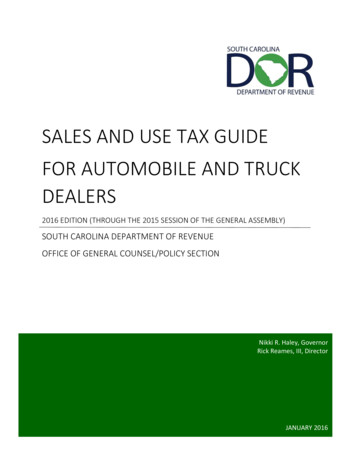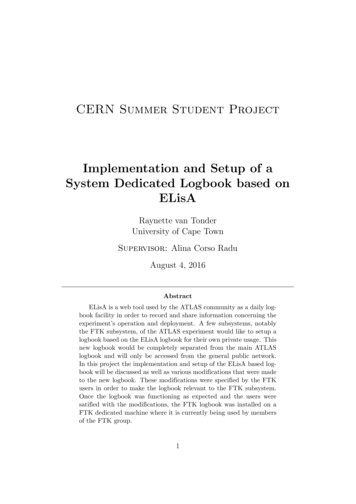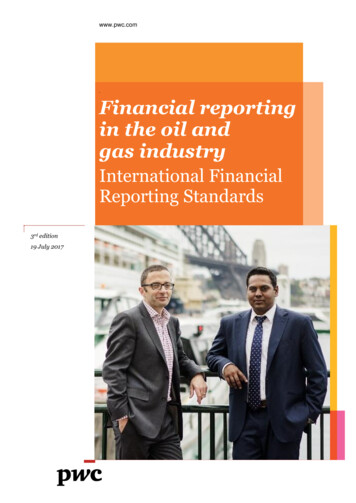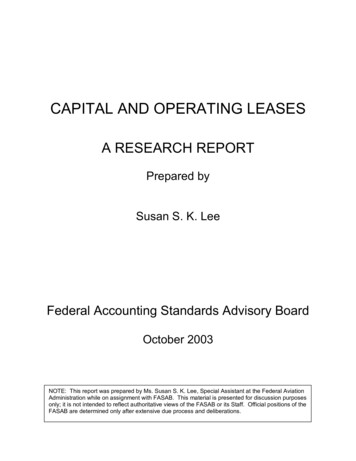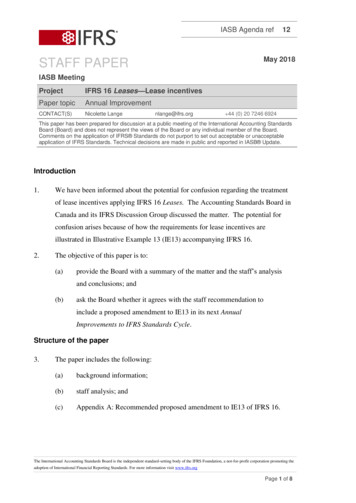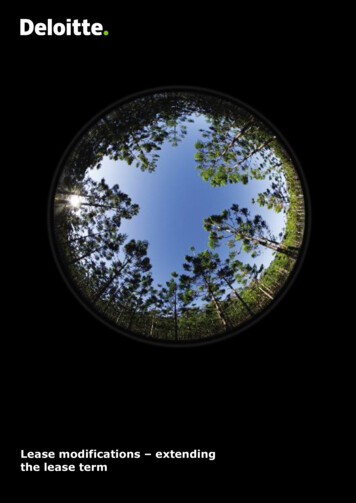
Transcription
Lease modifications – extendingthe lease term01
ContentsContents2Introduction3The focus of this publication4Interaction with transition reliefs5Steady-state application8Extending a lease – when should the additional RoU asset and lease liability berecognised?8Extension via a new contract9Extension plus a new asset – at market rates11Extension plus a new asset – not at market rates12Assessment of the lease term upon a lease extension14Scope of the modification guidance18Key takeaways21Appendix – relevant IFRS 16 guidance22Contacts242
IntroductionSeemingly innocuous changes to an agreement could be a leasemodification. They could affect your RoU asset and lease liabilityat unexpected times with major consequences for balance sheetratios.Are you prepared for them?IFRS 16 contains detailed guidance on how to account for lease modifications. A lease modification isdefined as a change in the scope of a lease, or the consideration for a lease, that was not part of theoriginal terms and conditions of the lease. A lease modification includes adding or terminating theright to use one or more underlying assets, or extending or shortening the contractual lease term.IFRS 16’s lease modification guidance can be summarised into the following diagram:Broadly speaking, a lease modification is accounted for in one of two ways:1. It is treated as a separate lease (IFRS 16.44); or2. It is not treated as a separate lease (IFRS 16.45-46).As can be seen from the diagram above, a modification will only be treated as a separate lease if itinvolves the addition of one or more underlying assets at a price that is commensurate with the03
standalone price of the increase in scope.1 All other modifications are not accounted for as a separatelease.The distinction between accounting for a modification as a separate lease or not as a separate leaseis important because it affects (i) when and (ii) the amount at which the modified RoU asset andlease liability are recognised.If a modification is a separate lease, a lessee applies the requirements of IFRS 16 to the newly addedleased asset independently of the original lease.In contrast, if a modification is not a separate lease, the accounting reflects that there is a linkagebetween the original lease and the modified lease. One of the consequences of this is that a lesseehas to allocate the modified consideration to each separate lease component in the modified contracton the effective date of the modification2, resulting in a remeasurement of the existing lease liabilityand RoU asset on that date.The application of these requirements are illustrated in the sections that follow.The appendix to this document reproduces the relevant IFRS 16 guidance on lease modifications.The focus of this publicationThis publication focuses on the extension of a lease. Specifically, it addresses the following issues:1) What constitutes a lease modification?2) When should a lease modification be accounted for?3) What is the impact of a lease modification on the lease term?4) How do the modification requirements interact with transition reliefs?We have chosen to focus on modifications involving lease extensions because they are pervasive andcould have a material impact on the amounts recognised in the financial statements; yet it is an areathat is often overlooked by practitioners.AbbreviationsRoU assetRight-of-use assetDIADate of initial applicationFor an addition of a RoU asset to be accounted for as a separate lease, the increase in consideration must be‘commensurate with the stand-alone price for the increase in scope and any appropriate adjustments to thatstand-alone price to reflect the circumstances of the particular contract’ (IFRS 16.44(b)). For ease of reference,that notion has been shortened to an increase in consideration that is ‘at market rates’ throughout thispublication.124See the appendix for relevant definitions.
Interaction with transition reliefsWhen an entity applies IFRS 16 for the first time, IFRS 16.C3 allows an entity to grandfather theprevious lease v. non-lease assessment of all existing contracts, even if applying the definition of alease in accordance with IFRS 16 would result in a different conclusion. Nevertheless, if an entityenters into a new lease or if an existing contract is modified after the DIA, the entity needs to assesswhether the contract is, or contains a lease, in accordance with the requirements of IFRS 16 (IFRS16.C4).In other words, the grandfathering practical expedient is not an immunity from future changes. Thiscan be seen in examples 1 and 2.Example 1Change in price to a grandfathered non-lease contractEntity A has a long-term energy purchase arrangement with a solar farm owner. The arrangementis assessed not to be a lease under IAS 17 and IFRIC 4. On transition to IFRS 16 on 1 January2019, Entity A chooses to grandfather the lease v. non-lease assessment in accordance with IFRS16.C3.In March 2019, Entity A renegotiates the pricing of the energy purchase arrangement with the solarfarm owner to align to market rates.5
AnalysisA change in consideration is a modification as defined because the change was not contemplated inthe original terms of the contract. Consequently as required by IFRS 16.C4, Entity A should assesswhether the long-term energy purchase contract is a lease by applying the definition of a lease inIFRS 16 upon pricing renegotiation.If Entity A concludes that the contract is a lease in terms of IFRS 16, it will have to recognise therelated RoU asset and lease liability in March 2019.ObservationSomething as innocuous as a change in price is a modification. Does your system flag this to you assuch? If not, what manual processes have you put in place to identify such changes?It is also worth noting that in example 1, the purchase contract was not accounted for as a lease ontransition to IFRS 16. It is probably recorded outside Entity A’s leases database and potentially notcovered by Entity A’s normal procedures on identifying lease modifications. What processes haveyou put in place to ensure modifications to such non-lease contracts are identified and brought toyour attention for a fresh assessment of whether it is a lease in terms of IFRS 16? This isparticularly important for borderline cases under IFRIC 4.Looking back at example 1, we can see that while the contract was off balance sheet on transitionto IFRS 16 and continues to be so in January and February 2019, the contract could be brought onbalance sheet in March 2019 if it is determined to be a lease under IFRS 16. Are you prepared forthat?Example 2Extending the term of a lease to which the para C10(c) practical expedient was appliedEntity B’s DIA of IFRS 16 is 1 January 2019. On the DIA, Entity B has various leases of retail shopsthat end on 30 November 2019. As the leases have a remaining lease term of less than 12 monthsfrom the DIA, Entity B elects to use the IFRS 16.C10(c) practical expedient to account for the leasesin the same way as short-term leases. These leases are therefore kept off balance sheet on theDIA.These leases do not contain any extension options. On 1 June 2019, each of these leases areextended for 12 months from 1 December 2019 to 30 November 2020.Entity B has a December year-end and reports interim results in June.6
AnalysisThe application of IFRS 16.C10(c) is tantamount to treating the leases as short-term leases fromthe DIA. Accordingly, Entity B applies the guidance in IFRS 16.5-8 to such leases. In accordancewith IFRS 16.7(a), when a short-term lease is modified, the lease is considered to be a new leaseon the effective date of the modification.Extending the lease term is a modification as defined because the extension was not contemplatedin the original terms of the lease. Consequently, Entity B should account for the leases as newleases from 1 June 2019, being the effective date of the modification.Each of the new leases has a commencement date of 1 June 2019 and a lease term of 1.5 years(from 1 June 2019 to 30 November 2020). As the lease term is longer than 12 months, the newleases do not meet the definition of a short-term lease and their related RoU assets and leaseliabilities will be recognised on 1 June 2019 and will appear in the 2019 interim financialstatements.ObservationSimilar to example 1, even though the leases were kept off balance sheet on the DIA, they aresubsequently brought on balance sheet because of a modification. This could have a significantimpact on your balance sheet ratios.What processes have you put in place to make sure modifications of short-term leases arecompletely identified? When changes are made to the leases database, does the system flag themto you as a potential modification? What processes are in place to make sure modifications of shortterm leases are treated as new leases with all the ensuing accounting requirements, includingdetermination of the lease term, allocating the consideration to lease and non-lease components,determining the discount rate etc.?7
Steady-state applicationExtending a lease – when should the additional RoU asset and lease liability berecognised?It is very common for entities to extend their leases before expiry of the lease. A question arises asto when the RoU asset and lease liability relating to the extended period should be recognised: Upon conclusion of negotiation? or At the start of the extended period?In cases where the original lease does not contain any extension options, the negotiation to extend alease constitutes a modification as defined. As the modification does not add the right to use one ormore underlying assets – it merely extends the entity’s right to use an existing leased asset to whichit already has access – the modification is not accounted for as a separate lease. Instead, themodification is accounted for at the effective date of the lease modification, which is the date whenboth parties agree to a lease modification (IFRS 16.45). See example 3.Example 3Extending a lease: when should the additional RoU asset and lease liability be recognised?Entity C has a lease that runs from 1 January 2019 to 31 December 2020 with no extension or earlytermination options. Six months before expiry, on 1 July 2020, Entity C and the lessor agree toextend the lease for another two years after expiry.AnalysisSince the original lease does not contain any extension options, the agreement to extend the leaseconstitutes a modification as defined. As the modification does not add the right to use one or moreunderlying assets, it is accounted for at the effective date of the lease modification, which is 1 July2020.8
Accordingly, Entity C remeasures the existing lease liability on 1 July 2020 to include the leasepayments for the extended period (2021 and 2022) using a revised discount rate (IFRS 16.45(c)). Acorresponding adjustment is made to the RoU asset (IFRS 16.46(b)).The ‘additional’ RoU asset and lease liability relating to the extended period are thereforerecognised on the date of modification and are not deferred until the start of the extended period.ObservationIs an extension of lease term identified as a modification by your system or other processes? Atwhat date does your system recognise the additional RoU asset and lease liability? In addition toasking you for the start date of the extended period, does the system require you to input theeffective date of the modification?Extension via a new contractIf a lessee enters into a new contract with a lessor (i.e. the original lease agreement remainsunchanged) that has the effect of extending the lease term of the existing lease without adding theright to use one or more underlying assets, the new contract should be accounted for as amodification of the existing lease.In other words, extending the contractual term of a lease meets the definition of a lease modificationregardless of whether the extension is effected through an amendment of the existing lease orentering into a new contract. See example 4.Example 4Extension via a new contractEntity D leases a retail shop for three years from 1 January 2019 to 31 December 2021. The leasedoes not have any renewal or early termination options. On 31 December 2020, the lessor calls foran open tender and Entity D decides to match the highest tender price. As a result, Entity D and thelessor enter into a new lease agreement for the same shop for three years to start after expiry ofthe current lease. The original lease remains unchanged.9
AnalysisThe substance of the transaction is that Entity D and the lessor have agreed to extend the lease ofthe current retail shop for three years. Extending the lease term constitutes a modificationregardless of whether the extension is effected through an amendment of the existing lease orentering into a new contract.Since the modification does not involve the addition of the right to use one or more underlyingassets, the modification is accounted for on the effective date of modification, i.e. on 31 December2020 (IFRS 16.45).Accordingly, Entity D remeasures the existing lease liability on 31 December 2020 to include thelease payments covered by the new lease (from 2022 to 2024) using a revised a discount rate. Acorresponding adjustment is made to the RoU asset. As such, the 2020 annual financial statementswill reflect this increased RoU asset and lease liability. The profit or loss from 1 January 2021onwards will include the depreciation and interest expense of the additional RoU asset and leaseliability.The RoU asset and lease liability relating to the new lease are recognised on the effective date ofmodification and are not deferred until the start of the period covered by the new lease.ObservationHow do your existing processes identify new leases that should be accounted for as a modification?In example 4, if the new contract signed on 31 December 2020 was incorrectly accounted for as anew lease, it would only be recognised on 1 January 2022, resulting in an error from 2020 onwards.Not only are the RoU asset and lease liability understated for both 2020 and 2021, the depreciation,interest expense and retained earnings from 1 January 2021 onwards would also be incorrect.10
Extension plus a new asset – at market ratesWhen a modification involves both an extension of the existing lease and an addition of anotherleased asset, an entity should assess whether the existing leased asset and the newly leased assetare separate lease components.The right to use an underlying asset is a separate lease component if:a. the lessee can benefit from use of the underlying asset either on its own or together withother resources that are readily available to the lessee, andb. the underlying asset is neither highly dependent on, nor highly interrelated with, the otherunderlying assets in the contract. (IFRS 16.B32)If the existing leased asset and the newly leased asset are separate lease components in terms of theabove criteria, then each of them should be accounted for as a separate lease (IFRS 16.12). Thisentails applying the modification guidance to each of the existing and newly added leased assetsseparately. Example 5 illustrates this point.Example 5Extension of lease plus a new asset – at market ratesEntity E leases 10,000m2 of office space for two years from 1 January 2019 to 31 December 2020.On 31 December 2019, Entity E and the lessor amend the lease to:I. extend the lease of the existing 10,000m2 for five years; andII. lease an additional 3,000m2 for five years, starting from 1 January 2021.The two office spaces are assessed as separate lease components in accordance with IFRS 16.B32.The consideration for the entire modification is commensurate with the sum of the market price ofboth components.11
AnalysisAs the two office spaces are assessed to be separate lease components, they are accounted for asseparate leases and the modification guidance is applied to each of them separately.The modification to include the additional 3,000m2 is accounted for as a separate lease because itincreases the scope of the lease by adding the right to use an underlying asset (extra space) atmarket rates. Accordingly, the new RoU asset and lease liability relating to the additional 3,000m2are recognised at the new lease’s commencement date, i.e. at 1 January 2021.The modification to extend the lease term of the existing 10,000m2 is not accounted for as aseparate lease because it does not involve the addition of the right to use one or more underlyingassets. Instead, consistent with examples 3 and 4, the extension is accounted for on the effectivedate of the modification, i.e. on 31 December 2019. Entity D remeasures the existing lease liabilityon 31 December 2019 to include the lease payments covered by the extended period (from 2021 to2025) for the existing 10,000m2 using a revised a discount rate. A corresponding adjustment ismade to the RoU asset. The 2019 annual financial statements will reflect this increased RoU assetand lease liability.Extension plus a new asset – not at market ratesWhen a modification occurs through the addition of a RoU asset (e.g. leasing an extra floor of officespace) at an off-market rate, the modification must be accounted for at the effective date of themodification in accordance with IFRS 16.45.Off-market pricing could happen when, for example, due to changes in market conditions the lesseeis paying above-market rent for an existing lease of property. If the lessee decides to lease anotherproperty from the same lessor, instead of adjusting the existing lease to market rent and payingmarket rent for the new property, both parties might agree to charge below-market rent for the newproperty such that on an aggregate basis the lessee is paying market rent for both leases.IFRS 16.45 requires a lessee, at the effective date of the modification, to:(a)determine the lease term of the modified lease;(b)allocate the consideration in the modified contract; and(c)remeasure the lease liability.Following the allocation of the consideration in the modified contract to the separate leasecomponents (including the new and the existing lease components) at the effective date of themodification, the lessee remeasures the lease liability for the existing RoU asset.Given the lack of clear guidance in IFRS 16, we believe that the RoU asset and lease liability relatingto the newly added leased asset should be recognised only when it is made available for use by thelessee (i.e. at the commencement date of that separate lease component), even if this date is laterthan the effective date of the modification (IFRS 16.22). The amounts recognised would reflect theconsideration allocated to this lease component at the effective date of the modification.12
Example 6 illustrates this point.Example 6Extension of lease plus a new asset – not at market ratesEntity F leases 10,000m2 of office space for two years from 1 January 2019 to 31 December 2020.On 31 December 2019, Entity F and the lessor amend the lease to:I.II.extend the lease of the existing 10,000m2 for five years; andlease an additional 3,000m2 for five years, starting from 1 January 2021.The consideration for the additional space is not commensurate with the standalone price of theadditional space. The original 10,000m2 and the additional 3,000m2 of office space are separatelease components in accordance with IFRS 16.B32.AnalysisSince the increase in consideration for the increase in scope (the additional 3,000m2) is not atmarket rate, Entity F applies IFRS 16.45 to account for the modification. Accordingly, on 31December 2019 which is the effective date of the modification, Entity F allocates the revised rentalsfor the modified contract to the two lease components, i.e. the existing 10,000m2 and theadditional 3,000m2 of office space, based on their relative standalone prices at that date.Following the allocation of the consideration to the separate lease components, Entity F accounts foreach lease component independently (IFRS 16.12). Consequently, Entity F remeasures the leaseliability and the RoU asset relating to the existing 10,000m2 on 31 December 2019 using a reviseddiscount rate. The 2019 annual financial statements will therefore reflect a revised RoU asset andlease liability for the existing 10,000m2 of office space.As regards the lease of the additional 3,000m2, we believe that the related RoU asset and leaseliability should be recognised at the commencement date of that separate lease component, i.e. on1 January 2021 when this space is made available for use by Entity F. The amount recognised13
reflects the consideration allocated to this additional space on the effective date of modification ofthe original lease.ObservationAs you can see from examples 5 and 6, regardless of whether the additional office space (leasedasset) is accounted for as a separate lease for the purposes of the modification guidance, as long asit is a separate lease component from the existing leased asset, it will only be recognised on thecommencement date which is the date when the additional asset is made available for use by thelessee.Nevertheless, the measurement basis for both the pre-existing and the additional leased asset isdifferent. If the modification is not accounted for as a separate lease, the modified consideration willbe allocated to the pre-existing and the additional lease components on a relative standalone pricebasis. On the contrary, if the modification is accounted for as a separate lease in accordance withIFRS 16.44, no reallocation is made.ObservationSee the scope of the modification guidance section below and example 10 for a discussion ofwhether the lease modification guidance applies when a lessee enters into a new agreement withthe same lessor for different assets.Assessment of the lease term upon a lease extensionThe determination of lease term upon a lease extension depends on whether the original lease was ashort-term lease.If the original lease was not a short-term lease, a lessee applies IFRS 16.44-46 to the modification.In the context of an extension of the lease term, since it does not add the right to use one or moreunderlying asset, the lease is accounted for as a continuation of the original lease and so the leaseterm spans from the commencement date of the original lease to the end of the extended period. Seeexample 7.If the original lease was a short-term lease, a lessee applies IFRS 16.7 to the modification. IFRS 16.7requires any modification of a short-term lease to be considered a new lease on the effective date ofthe modification. This means that an entity will need to reassess the lease term of the new lease todetermine if it continues to qualify for the short-term lease exemption. See examples 8 and 9.14
Example 7Assessment of lease term upon a lease extension – original lease is not a short-termleaseEntity A has a lease for two years that runs from 1 January 2019 to 31 December 2020. There areno extension options. The lease is extended on 1 October 2020 for six months from 1 January 2021to 30 June 2021.AnalysisThe agreement to extend the lease is a modification because it was not contemplated in the originalterms of the lease. Since the modification does not add the right to use one or more underlyingassets, it does not meet the criteria in IFRS 16.44(a) to be accounted for as a separate lease. Thecommencement date of the modified lease remains to be 1 January 2019, i.e. the date when theRoU asset was first made available for use by Entity A.Accordingly, the total lease term of the modified lease is 2.5 years. It would be incorrect to treatthe lease as a short-term lease from 1 October 2020, being the effective date of the modification,on grounds that the remaining term of the lease is nine months from that date.15
Example 8Original lease is a short-term lease – modification that qualifies for a short-term leaseEntity B has a short-term lease that runs from 1 January 2019 to 31 December 2019. There are noextension options. The lease is extended on 1 October 2019 for six months from 1 January 2020 to30 June 2020.Entity B elects to apply the short-term lease recognition exemption in accordance with IFRS 16.5 toall short-term leases.AnalysisSince the original lease is a short-term lease to which Entity B has elected to apply the short-termlease exemption, IFRS 16.6-8 applies.In accordance with IFRS 16.7(a), the lease is considered to be a new lease if there is a modificationor a change in the lease term. There is a modification on 1 October 2019 because the lease hasbeen extended and this extension was not contemplated in the original terms of the lease.Consequently, the new lease has a commencement date of 1 October 2019 and a lease term of ninemonths, thus it meets the definition of a short-term lease and qualifies for the short-term leaseexemption from 1 October 2019.The consideration for the modified lease (i.e. existing rentals for October to December 2019 plusnew rentals for January to June 2020) will be straight-lined over the term of the new lease from 1October 2019 to 30 June 2020.16
Example 9Original lease is a short-term lease – modification that does not qualify for a short-termleaseEntity K has a short-term property lease that runs from 1 January 2019 to 31 December 2019.There are no extension options. On 1 October 2019, Entity K and the lessor enter into a new leaseto rent the same premises for 12 months from 1 January 2020 to 31 December 2020.Entity K elects to apply the short-term lease recognition exemption in accordance with IFRS 16.5 toall short-term leases.AnalysisSince the original lease is a short-term lease to which Entity K has elected to apply the short-termlease exemption, IFRS 16.6-8 applies.In accordance with IFRS 16.7(a), the lease is considered to be a new lease if there is a modificationor a change in the lease term. As discussed in the ‘extension via a new contract’ section, enteringinto a new lease on the same underlying asset that has the effect of extending the lease term of theoriginal lease is a modification as defined.Consequently, the new lease for the purposes of IFRS 16.7(a) has a commencement date of 1October 2019 and a lease term of 15 months, thus it does not meet the definition of a short-termlease. As such, Entity K should recognise a RoU asset and lease lability for the new 15-month leaseon 1 October 2019. The RoU asset and lease liability will appear in the 2019 annual financialstatements.ObservationHow did you set up your system and processes to identify whether something is a short-term lease?In example 9, the new legal contract signed on 1 October 2019 is for a term of 12 months so itwould have met the definition of a short-term lease had it not been for the application of the17
modification requirements. If your system and processes merely ask whether the new lease has alease term of 12 months or less, the answer to which is yes, you would have accounted for themodification incorrectly.How do your processes identify new contracts that should be accounted for as a modification?Specifically, how do those processes identify new contracts or renewals that should be brought onbalance sheet?ObservationExample 9 is a very common example of rolling 12-month leases. The continued 12-monthextensions every year before expiry of the original lease would cause the contract to fail the shortterm lease definition. The lease will have to be brought on balance sheet upon the first extension asseen in example 9.Scope of the modification guidanceAs discussed previously, a lease modification can arise from a lessee and lessor modifying the termsof an existing lease or by entering into a new agreement without directly changing the terms of anexisting lease.Furthermore, a lease modification can arise when a lessee and lessor with existing lease contract(s)enter into a new lease for a different asset. Example 10 illustrates this scenario.Example 10Scope of the modification guidance – entering into a new lease contract with an existinglessor for different assetsEntity X leases two floors of an office building in Hong Kong (HK) from Lessor Y for six years. At theend of Year 4, due to expansion needs, Entity X enters into various new contracts with Lessor Y tolease properties in Beijing for five years to start immediately. The original lease remainsunchanged.18
AnalysisAs Entity X has a pre-existing lease arrangement with Lessor Y, Entity X should apply themodification guidance to assess how the new Beijing leases should be accounted for.Since the Beijing leases add the right to use one or more underlying assets when compared to theoriginal HK lease, Entity X assesses whether the consideration for the Beijing leases is at marketrates in order to assess whether they should be accounted for as separate leases from the originallease of the HK office.If the consideration for the Beijing leases is at market rates, the new contracts would be accountedfor as separate leases (IFRS 16.44).If, on the other hand, the consideration for the Beijing leases is not at market rates, Entity X shouldconsider all relevant facts and circumstances to determine the business and commercial rationalefor the off-market pricing.If Entity X concludes that the consideration for the Beijing leases was influenced by the pricing ofthe original HK lease as opposed to other non-lease contracts, the lease modification guidanceapplies. In such a case, Entity X should allocate the consideration of the Beijing leases and theoriginal HK lease to the separate lease components (i.e. each of the Beijing and HK properties)based on their relative standalone price at the end of Year 4, being the effective date of themodification.Following the allocation of the modified consideration to the separate lease components, Entity Xaccounts for each lease component as a separate lease (IFRS 16.12). Consequently, Entity Xremeasures the lease liability and RoU
2 Contents Contents 2 Introduction 3 The focus of this publication 4 Interaction with transition reliefs 5 Steady-state application 8 Extending a lease - when should the additional RoU asset and lease liability be recognised? 8 Extension via a new contract 9 Extension plus a new asset - at market rates 11 Extension plus a new asset - not at market rates 12





